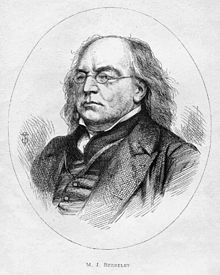Miles Joseph Berkeley: Difference between revisions
m simplify author abbr. notice with botanist template |
Rotational (talk | contribs) Replaced old image with better one and changed botanist abbreviation format to less clumsy version |
||
| Line 1: | Line 1: | ||
| ⚫ | |||
'''Miles Joseph Berkeley''' ([[April 1]], [[1803]] – [[July 30]], [[1889]]) was an [[England|English]] [[ |
'''Miles Joseph Berkeley''' ([[April 1]], [[1803]] – [[July 30]], [[1889]]) was an [[England|English]] [[Cryptogam|cryptogamist]] and clergyman. |
||
| ⚫ | |||
Berkeley was born at Biggin Hall, [[Northamptonshire]], and educated at [[Rugby School]] and [[Christ's College, Cambridge]], of which he became an honorary fellow. Taking [[holy orders]], he became incumbent of [[Apethorpe]] in [[1837]], and vicar of Sibbertoft, near [[Market Harborough]], in [[1868]]. He acquired an enthusiastic love of [[cryptogamic]] [[botany]] ([[lichen]]s) in his early years, and soon was recognized as the leading British authority on [[fungi]] and [[plant pathology]]. |
Berkeley was born at Biggin Hall, [[Northamptonshire]], and educated at [[Rugby School]] and [[Christ's College, Cambridge]], of which he became an honorary fellow. Taking [[holy orders]], he became incumbent of [[Apethorpe]] in [[1837]], and vicar of Sibbertoft, near [[Market Harborough]], in [[1868]]. He acquired an enthusiastic love of [[cryptogamic]] [[botany]] ([[lichen]]s) in his early years, and soon was recognized as the leading British authority on [[fungi]] and [[plant pathology]]. |
||
| Line 11: | Line 10: | ||
It is as the founder of British mycology, however, that his name will live in the history of botany, and his most important work is contained in the account of native British fungi in Sir W. Hooker's ''British Flora'' (1836), in his ''Introduction to Cryptogamic Botany'' (1857), and in his ''Outlines of British Fungology'' (1860). His magnificent herbarium at [[Kew]], which contains over 9000 specimens, and is enriched by numerous notes and sketches, forms one of the most important type series in the world. |
It is as the founder of British mycology, however, that his name will live in the history of botany, and his most important work is contained in the account of native British fungi in Sir W. Hooker's ''British Flora'' (1836), in his ''Introduction to Cryptogamic Botany'' (1857), and in his ''Outlines of British Fungology'' (1860). His magnificent herbarium at [[Kew]], which contains over 9000 specimens, and is enriched by numerous notes and sketches, forms one of the most important type series in the world. |
||
The standard [[List of botanists by author abbreviation|author abbreviation]] '''Berk.''' is applied to species he described. |
|||
{{botanist|Berk.|Berkeley, Miles Joseph}} |
|||
==References== |
==References== |
||
Revision as of 14:16, 8 March 2008

Miles Joseph Berkeley (April 1, 1803 – July 30, 1889) was an English cryptogamist and clergyman.
Berkeley was born at Biggin Hall, Northamptonshire, and educated at Rugby School and Christ's College, Cambridge, of which he became an honorary fellow. Taking holy orders, he became incumbent of Apethorpe in 1837, and vicar of Sibbertoft, near Market Harborough, in 1868. He acquired an enthusiastic love of cryptogamic botany (lichens) in his early years, and soon was recognized as the leading British authority on fungi and plant pathology.
He was especially famous as a systematist in mycology, some 6000 species of fungi being credited to him, but his Introduction to Cryptogamic Botany, published in 1857, and his papers on Vegetable Pathology in the Gardener's Chronicle in 1854 and onwards, show that he had a very broad grasp of the whole domain of physiology and morphology as understood in those days. Moreover, it should be pointed out that Berkeley began his work as a field naturalist and collector, his earliest objects of study having been the mollusca and other branches of zoology, as testified by his papers in the Zoological Journal and the Magazine of Natural History, between 1828 and 1836.
As a microscopist he was an assiduous and accurate worker, as is shown by his numerous drawings of the smaller algae and fungi, and his admirable dissections of mosses and Hepaticae. His investigations on the potato murrain, caused by Phytophthora infestans, on the grape mildew, to which he gave the name Oidium Tuckeri, and on the pathogenic fungi of wheat rust, hop mildew, and various diseases of cabbage, pears, coffee, onions, tomatoes, &c., were important in results bearing on the life-history of these pests, at a time when very little was known of such matters, and must always be considered in any historical account of the remarkable advances in the biology of these organisms which were made between 1850 and 1880. When it is remembered that this work was done without any of the modern appliances or training of a properly equipped laboratory, the real significance of Berkeley's pioneering work becomes apparent.
It is as the founder of British mycology, however, that his name will live in the history of botany, and his most important work is contained in the account of native British fungi in Sir W. Hooker's British Flora (1836), in his Introduction to Cryptogamic Botany (1857), and in his Outlines of British Fungology (1860). His magnificent herbarium at Kew, which contains over 9000 specimens, and is enriched by numerous notes and sketches, forms one of the most important type series in the world.
The standard author abbreviation Berk. is applied to species he described.
References
- This article incorporates text from a publication now in the public domain: Chisholm, Hugh, ed. (1911). Encyclopædia Britannica (11th ed.). Cambridge University Press.
{{cite encyclopedia}}: Missing or empty|title=(help)
Further reading
- Taylor, George (1970). "Berkeley, Miles Joseph". Dictionary of Scientific Biography. Vol. 2. New York: Charles Scribner's Sons. pp. 18–19. ISBN 0684101149.
